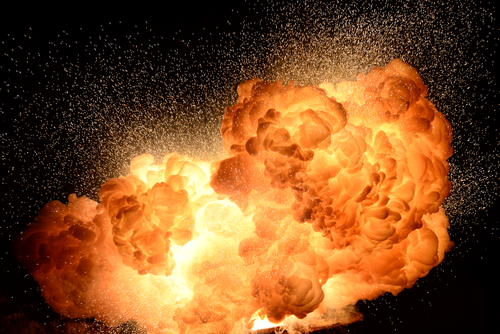Combustible dust explosions have destroyed workplaces and killed employees. Take action now to prevent a disaster.
 |
A comprehensive approach to preventing and controlling combustible dust hazards is essential to prevent deadly explosions. Some general rules include the following:
- Do not allow employees to use compressed air, dry sweeping, or other cleaning methods that can disperse combustible dust into the air (when feasible).
- Pay particular attention to workforce training and education regarding recognition and control of combustible dust hazards, and make sure employees follow the instructions given at the training sessions.
- Limit and control potential ignition sources in dust accumulation areas.
- Maintain an effective housekeeping program to prevent or eliminate dust buildup on ledges, ductwork, building framing, or other surfaces. (Even small accumulations of dust (as little as 1/32 of an inch) can create a dust explosion hazard if spread over sufficient surface area.)
- Establish and maintain a preventive maintenance program to preserve the integrity of process equipment and minimize the release of fugitive dust particles.
- Ensure electrical service in combustible dust areas is appropriate for hazardous (Class II) locations, as required by the National Electrical Code.
- Follow NFPA Standard 654, Standard for the Prevention of Fire and Dust Explosions from Manufacturing, Processing, and Handling of Combustible Particulate Solids, and other NFPA dust explosion prevention standards for specific industries, as applicable.
- Ensure operations involving dusts have proper engineering design and controls.
Make sure your workplace and your workers are safe from combustible dust hazards. Get the vital safety information you need in a Free Best Practices Report. Find out how to get your copy. Click here.
Recognizing Hazards
A thorough, formal hazard assessment is essential in identifying and eliminating factors contributing to an explosion. But it is also important for every employee to be doing an informal hazard assessment every day.
Instruct employees to always be on the lookout for accumulations of dust. And that doesn’t mean just out in the open. They should check above, below, behind, and inside storage containers, ductwork, dropped ceilings, etc.
You and employees should also check for ignition sources. Only a couple of dust types spontaneously ignite in air; the majority of them need another source of ignition. Possible ignition sources include:
- Open flames (welding, cutting, matches, etc.)
- Hot surfaces (dryers, bearings, heaters, etc.)
- Heat from mechanical impacts
- Electrical discharges (switch and outlet activation)
- Electrostatic discharges
- Smoldering or burning dust
- Cigars, pipes, and cigarettes
In addition, ask questions such as the following:
- Is vacuuming used whenever possible rather than blowing or sweeping combustible dust?
- Do you have electrical installations in hazardous dust or vapor areas? If so, do they meet the National Electrical Code (NEC) Chapter 5 for hazardous locations?
- Are accumulations of combustible dust routinely removed from elevated surfaces, including the overhead structure of buildings, dropped ceilings, shelves, etc.?
- Is metallic or conductive dust prevented from entering or accumulating on or around electrical enclosures or equipment?
- Where may dust accumulate that we have not considered?
- Has the possibility that wood dust can decay and create their own heat as a possible source of ignition been addressed?
Don’t leave your employees vulnerable to combustible dust explosions. Make sure your workplace is safe. A free Best Practices Report can tell you what you need to do. Find out more
Combustible dust is an innocent-looking disaster waiting to happen. Everyone in your workplace should be aware of this potential hazard and should take every precaution to be sure that your workplace stays safe from sudden explosions and the other hazards of combustible dust.
Learn what you need to know about this terrible risk in a FREE Best Practices Special Report from BLR and Camfil APC, manufacturer of cartridge dust and fume collectors that deliver safe air for a safe work environment.
To access your FREE copy of Combustible Dust, click here.
